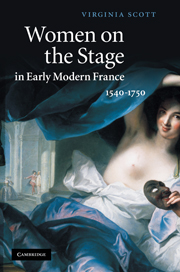Book contents
- Frontmatter
- Contents
- Acknowledgments
- Introduction
- 1 The actress and the anecdote
- 2 “So perverse was her wantonness”: antitheatricalism and the actress
- 3 In the beginning: “12 livres per year”
- 4 “Those diverting little ways”: 1630–1640
- 5 Mademoiselle L'Étoile: 1640–1700
- 6 “Embellished by art”: 1680–1720
- 7 Lives and afterlives: 1700–2010
- Bibliography
- Index
7 - Lives and afterlives: 1700–2010
Published online by Cambridge University Press: 03 May 2011
- Frontmatter
- Contents
- Acknowledgments
- Introduction
- 1 The actress and the anecdote
- 2 “So perverse was her wantonness”: antitheatricalism and the actress
- 3 In the beginning: “12 livres per year”
- 4 “Those diverting little ways”: 1630–1640
- 5 Mademoiselle L'Étoile: 1640–1700
- 6 “Embellished by art”: 1680–1720
- 7 Lives and afterlives: 1700–2010
- Bibliography
- Index
Summary
LIVES
Between 1700 and 1750, the Parisian theatre underwent many significant changes. Actresses were less likely to be born into theatrical families, less likely to be married to fellow actors (or, indeed, married at all). Some were enthusiastic participants in le monde, the famously libertine social, artistic, and literary milieu that developed in Paris after the death of Louis XIV in 1715. Although their sexual adventures were greatly exaggerated by the gossip-mongers and the morals police, some actresses had affairs with noblemen and even royals, others built irregular marriages and long-lasting relationships with important men. One result was the reinforcement of the old stereotypes, a growing habit of generalizing “the actress,” and increased hostility toward “public” women. More is known about eighteenth-century actresses than about earlier ones, but the evidence can be contradictory, and certain narratives need to be challenged.
Actresses were important to the survival of the theatre in the eighteenth century. The Comédie-Française often sailed on perilous financial seas, and the women played an important role in keeping it afloat, their star power as great or greater than that of the actors. But as the troupe became ever more institutionalized under the agents of the monarchy, the women lost even more control than the men did of the management of what had once been their “republic.”
- Type
- Chapter
- Information
- Women on the Stage in Early Modern France1540–1750, pp. 246 - 288Publisher: Cambridge University PressPrint publication year: 2010



